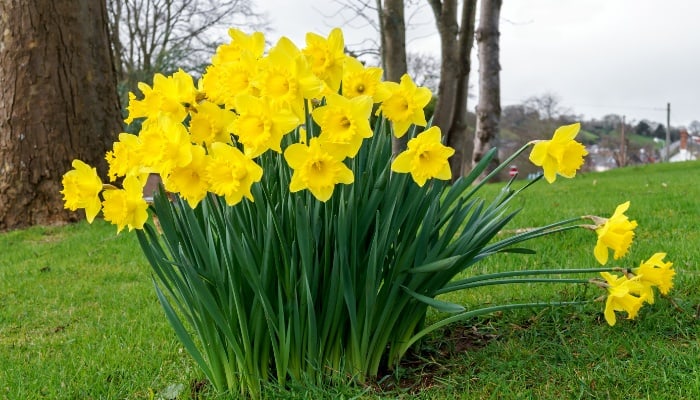Daffodils are vibrant and joyful flowers that transform any garden into a lively display of hues. Despite their brief lifespan, they are well worth the time and care invested in cultivating them.
However, sometimes the spritely daffodils may show signs of disease or start drooping.
Why are my daffodils drooping? Drooping is a common problem with daffodils. It can be caused by too much rain or snow, strong winds, inadequate watering, lack of nutrition, wrong soil depth, or excessively hot temperatures. Drooping could also be part of the life cycle of certain daffodil varieties.
A drooping daffodil doesn’t mean that the plant is dead, but if you don’t intervene, you could lose your flowering plants. Read more to find out what causes daffodils to droop and what you can do about it.
Drooping Daffodils: 7 Causes & What To Do
Daffodils are sensitive plants that respond quickly to changes in growing conditions. One of those responses is to droop. It’s an alarming sign that means you should find the cause of the problem and fix it quickly.
1. Natural Growth of Your Particular Variety
Some daffodil varieties have a short life cycle, and they will droop once they have reached the end of their life. There’s nothing you can do about that.
Solution
If you don’t like your daffodil dropping as part of its natural growth, choose another variety that comes back year after year and resists drooping.
2. Heavy Rain or Snow
Heavy rain can weaken the stems of daffodils causing them to flop over or droop. This is also a problem if you get heavy snowfall that undermines the integrity of the tissue of the stems.
Snow is also heavier than rainwater and tends to weigh down the blooms quickly.
Solution
To protect your daffodils from heavy rainfall, cover them with row covers. That way the rain will not hit the stems and cause them to droop. This is also the best way to avoid heavy snowfall from damaging daffodils.
3. Strong Winds
Strong wind can also knock down your daffodils, causing them to flop over and droop. When the soil is wet, the roots of the plant can’t keep the flowers upright, and the daffodil will topple down.
Solution
Erect walls and fences around the daffodil patch to protect them against strong winds. If that doesn’t work, consider choosing a less windy spot for the sensitive plants.
4. Watering Issues
Daffodils need different watering at different stages of their lives. In the first few weeks after planting, you’ll need to water them as often as every day. Once the roots establish, cut watering down to once a week.
Too much water can cause the roots to rot and the plant to droop. Drought also has the same effect on the plant. The roots will die, and the crown will follow.
Solution
Follow the recommended watering patterns carefully, and avoid flooding the soil or allowing it to dry out. Once the plant establishes, it will rely less and less on the water you give it, but keep watering it once a week, and factor in the rainfall.
5. Unusually Hot Temperatures
High temperatures cause the daffodil to lose the moisture in the leaves faster than the roots can replenish it. As a result, the plant will droop and the leaves will turn yellow.
The excessive heat will also cause the soil to dry out fast, which limits the moisture the roots can absorb.
Solution
Protect your daffodils with shade in the hot afternoons. Also, cover the soil with mulch to improve water retention and keep the roots cool.
If hot summers are a norm, choose a spot for daffodils that faces the north or east to avoid exposure to the afternoon sun.
6. Incorrect Planting Depth
When planting daffodil bulbs, you need to dig a hole in the soil twice the height of the bulb. The hole should be 4 to 6 inches deep.
If you plant the daffodil in shallow soil, the roots will not hold the weight of the crown, which causes the plant to droop and keel over easily.
Solution
Plant the daffodils at the right depth. Make sure the bulb is 4 to 6 inches under the surface to allow the roots to develop and provide a strong foundation for the plant.
7. Fertilization Issues
Too much fertilizer in the soil causes root burn. This in turn affects the moisture and nutrition the plant gets from the roots. The stems become weak and can’t hold the top-heavy plant, and the daffodil will droop.
Solution
Use a mild liquid fish emulsion fertilizer (this one is excellent), and mix it with water. Apply the fertilizer around the base of the plant without touching it.
Daffodils benefit from one application in the early spring.
Daffodil Care

Although daffodils are easy to care for, they still require some attention, especially in the early stages of the plant’s life.
Getting those conditions right will give the daffodil a head start and avoid issues down the line.
Planting Location & Depth
For the best results, choose a location that gets 6 to 8 hours of sunlight. The soil should be quick to drain and rich. Amend it with perlite, and add organic materials.
Dig a hole 4 to 6 inches deep in the soil, and plant the daffodil bulb with its pointy end up. Cover the hole with soil, and water it.
Watering
Until the daffodil develops a full root ball, it will rely on the water coming from the surface. You’ll need to water the seedling between 2 and 3 times a day.
If the soil dries quickly, water it every day, and use mulch to improve water retention. Once the daffodil establishes, you can cut back watering to once a week during the growing season.
Fertilization
Daffodils don’t need a lot of fertilizing. Just one application in the early spring is enough. Use a mild liquid fertilizer at half-strength.
I recommend fish emulsion fertilizer since it won’t burn the roots or stress the plant with sudden growth spurts.
What To Do With Daffodils After Flowering?
After the bloom season, daffodils tend to die back. The foliage withers and turns brown (leave green leaves in place as they are critical in storing nutrients for the next season), but the bulbs in the soil are still viable.
You can leave the bulbs in the garden until they grow the next season, or you can dig them up, air-dry them, and store them in a cool, dry place.
Related Questions:
How Long Do Daffodils Bloom?
The bloom time of daffodils varies a lot depending on the Zone and the cultivar. In warm seasons, some cultivars can stay in bloom for 6 months.
Colder Zones impact the bloom time as well, and the daffodils could stay in bloom for just 6 weeks every year.
Do Daffodils Spread?
Daffodils won’t soon overtake your garden, but they may spread eventually. When you plant them in a spot in the garden, they’ll continue to grow back year after year with more and more flowers, and over time, they may begin to naturalize if left untended.
Closing Thoughts
Daffodils droop for different reasons. Inadequate watering, drought, strong winds, heavy rainfall, and excessive snow are some of the causes of drooping daffodils.
If the roots are too shallow, the plant will keel over under its own weight. Protect your daffodils with a makeshift cover against extremely hot sun, strong wind, rain, and snow.

